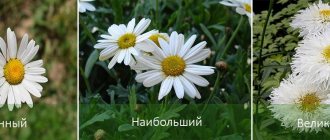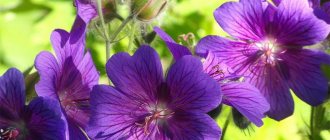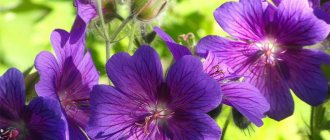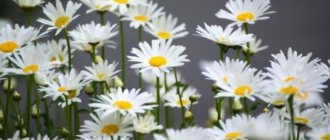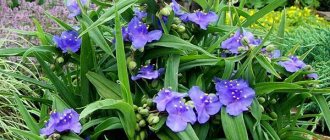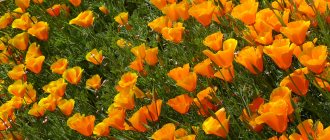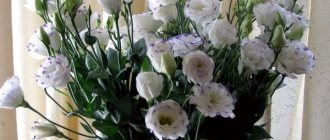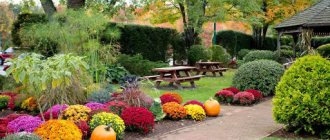Daisies are beautiful, romantic flowers that are often preferred by gardeners to decorate their garden landscapes.
Large garden daisies are easy to grow, they do not require special care and are perennial plants - which is not an ideal option for decorating your favorite garden. But before you grow a herbaceous plant, it doesn’t hurt to familiarize yourself with the basic conditions for growing healthy and flowering daisies.
Description of garden perennial chamomile
The brightest large-flowered plants are used to decorate flower beds.
Flower growers first became interested in daisies more than two hundred years ago, so many cultivated varieties have appeared over the years. And although perennial garden daisies can be of different heights, have different flowering times and inflorescence shapes, all daisies have much in common. First of all, this is a recognizable form of an inflorescence-basket, the core of which consists of small tubular yellow flowers, and the frame is made of false-ligulate petals.
Today, thanks to the efforts of breeders, semi- and double varieties of garden chamomile are available to gardeners.
Compared to wild specimens in cultivated perennials:
- flowers are larger;
- bud formation is much more active;
- the flowering period is longer;
- flowers may reappear in the second half of summer.
In early spring, a rosette of oblong basal leaves appears above the soil. When inflorescences appear on faceted, erect stems, the height of the plant can vary from 20 to 80 cm. Depending on the variety, the diameter of the inflorescences can reach from 3 to 10 cm.
Botanical description
All representatives of the daisy genus have a weak but characteristic odor . The plant is widely used in folk and traditional medicine because it has antiseptic and anti-inflammatory properties. In addition, the plant can be used in landscape design and for arranging bouquets of wildflowers.
The classification of chamomile is still not streamlined . There are several systems for its description, each of which considers several dozen species of this plant. The most popular type of chamomile is Chamomile. It is this species that has the most pronounced medicinal properties.
Sometimes daisies are also called other plants that are similar in appearance to this flower. These include pyrethrum, cornflower, as well as some types of asters and chrysanthemums. And, although from a botanical point of view this is not true, all these plants are grown in approximately the same way as ordinary chamomile.
pharmaceutical camomile
Chamomile is a low herbaceous perennial plant with pinnate, dissected leaves.
The chamomile inflorescence is a semicircular basket containing several hundred small flowers. The diameter of the inflorescences ranges from 5 to 20 mm. Their center is yellow or yellow-orange in color, the outer leaves are almost always white. The structure of the inflorescence is quite interesting: in the center there are bisexual flowers, at the edges there are only flowers with pistils.
Chamomile inflorescence
Flowering begins quite early . Usually, the first inflorescences appear at the very beginning of spring, in warm areas sometimes as early as early March. Since flowering does not occur simultaneously, blooming daisies can be found even in one area throughout the entire season - from early March to late October. Peak flowering occurs between May and July. Pollination is carried out by wasps or bees.
The fruits of the plant are achenes with a pappus . Fruit ripening occurs within 1-1.5 months after the end of flowering.
Chamomile is grown to produce pharmaceutical raw materials, primarily essential oils and azulene . For this purpose, the inflorescences and tops of the plant are collected.
Growing chamomile from seeds
Sowing chamomile
Growing chamomile is possible in seedlings and without seedlings. You can sow garden chamomile seeds simply in the ground, but it is safer to use the seedling method.
Chamomile seeds are sown for seedlings in March. Trays with cells are filled with a moist, light, breathable substrate consisting of peat and sand in equal parts, 2-3 seeds are placed in each cell, sprinkled with a thin layer of substrate on top, the container is covered with a transparent film and placed close to the window, but not on window sill, since the light passing through the glass is too intense and can damage the seed germination process. Monitor the condition of the soil, and as soon as it dries, moisten it with a spray bottle.
Chamomile seedlings
When the seedlings begin to appear, and at normal room temperature this will happen in one and a half to two weeks, remove the film and place the container as close to a sunny window as possible, protecting the seedlings from drafts. If this is not possible for any reason, place a fluorescent lamp over the container, which should work for at least 14 hours a day. As soon as the chamomile seedlings reach a height of 5 cm, leave only one, the most developed seedling, in each cell.
Do not pull out unnecessary seedlings, but carefully pinch them off above the soil surface, because you risk damaging the root system of the remaining seedling. In order for chamomile to bush, pinch it over 3-4 leaves.
Features of care
Garden chamomile is a large perennial, planting and caring for which will not cause much trouble for the gardener; although the plant is unpretentious, for the beauty and lushness of color it is necessary to follow a number of simple rules and recommendations:
- Watering - after planting the plant, it should be carried out frequently and systematically until the flowers take root, but without overwatering the soil. After strengthening the bushes, it is necessary to moisten the soil only during prolonged dry weather. The optimal time for watering is morning or evening, when there is no scorching sun. It is impossible to irrigate plants in extreme heat, as this will lead to burns on the foliage.
- Cover the soil with mulch, which can be sawdust or peat. Mulch helps keep the soil moist longer.
- Loosening the soil and weeding the plant is mandatory.
- For lush color, it is necessary to feed the plant with nitrogen fertilizers. They are introduced in the spring at the root. In early spring, it is recommended to additionally feed the bushes with urea.
Some gardeners use collected leaves as mulch, but this is not recommended, since the leaves may contain spores of a pathogenic fungus that will be transferred to the flowers.
For irrigation, it is recommended to use settled or rain water, not cold water.
Features of the fertilizer:
- To make the leaves have a rich green color, chicken droppings or mullein are used.
- You can prepare the nutritional composition yourself - pour 1 bucket of water over an armful of freshly cut grass and leave for 7 days. Dilute the finished infusion - 1 liter per 1 bucket of water.
- Fertilizing is combined with watering. First, the ground under the bush is moistened, then a nutrient solution is added, after which the plant is watered again. This procedure promotes better penetration of nutrients to the root system.
- A mandatory fertilizer that is applied in May is nitrophoska (2 tablespoons of the product are diluted in 10 liters of water).
Dry inflorescences must be cut off along with the stem so that the plant regains its strength faster and new huge flowers begin to form.
Autumn care
You need to care for the plant in the fall:
- if the soil is acidic, dolomite flour or slaked lime must be added to it;
- With the onset of autumn, sanitary cleaning of the bushes is carried out - bad and weak stems and dead parts of the plant are cut off, and dry leaves and flowers are necessarily removed.
Sanitary pruning is carried out as necessary, when the bush has grown greatly, the stems or leaves have begun to turn yellow, bad and damaged parts must be removed immediately.
Damaged bushes are subjected to sanitary pruning
Preparing for winter
Despite the frost resistance of the plant, in regions with severe frosts or in the event of a snowy winter, the bushes may freeze. Before the onset of cold weather, flowers must be prepared for wintering - cut the stems to the soil, cover them with peat or wrap them in non-woven material.
How to plant a large garden chamomile in open ground
Before planting garden chamomile, it is imperative to prepare the soil for more efficient absorption of the shrub, regardless of how it is grown.
The most successful option for transforming any soil into a favorable environment for any variety is considered to be fertilizing with universal flower fertilizers. They can be either organic (low concentration) or mineral. Although, if you wish, you can purchase special preparations for such purposes in the store.
When and how to plant?
If the method of sowing seeds was chosen for planting, it is better to start growing in March. It’s good if you plant the seeds not in open ground, but in special containers (disposable plastic cups can be used), because there they will germinate better and be better accepted on the site.
Seedlings are planted at the beginning of May, so that the plant has time to assimilate into the new environment.
When the ground is ready, holes are dug for planting, 20-30 cm deep with indentations of 20-40 cm from each other. After planting, the plant is watered abundantly with clean water or diluted means to stimulate growth.
Chamomiles will begin to bloom within a year.
When is the best time to replant garden chamomile?
September is a good time for transplanting and dividing bushes, since an adult plant is accepted quickly and already feels comfortable in a new place by the cold weather.
Favorite varieties of gardeners
Milky-flowered peony (Paeonia Lactiflora) - growing features
Chamomiles are very popular in gardening. The plants are unpretentious and are perfect for implementing landscape ideas. The following varieties are most widespread:
- Alaska. A variety reaching 80-90 cm in height. It has a huge flower diameter - 12 cm. The plant loves areas protected from wind and drafts. Alaska is sun-loving, frost-resistant and tolerant of lack of moisture.
- Silver Princess. The plant reaches 35-40 cm in height. Flower - about 10 cm. Likes regular watering. Differs from others by long flowering. An excellent option for a summer residence.
- North Star. This shrub reaches 70 cm in height. Flower diameter 12 cm. Tolerates drought.
- Stern von Antwerp. A meter tall plant with a flower diameter of 10 cm. Loves the sun and regular watering.
- Beethoven. This variety reaches 80 cm. The diameter of the flower is 12 cm. It is distinguished by the abundant lushness of the bushes.
- Schwabengrub grows up to 80 cm. The diameter of the flower is 10-12 cm. This is a double chamomile.
- Little Princess. Low chamomile no more than 10-12 cm high. Flower diameter - 6-7 cm.
- Maxima Koenig. This variety of cornflower grows up to 70-100 cm. Flower diameter is 10-12 cm.
- Sans Souci. It is called a giant flower. It grows up to 1 m in height. Flower diameter from 12 cm.
- Mae Queen has average characteristics. It is considered short, as its height is no more than 50 cm.
- Persian. This variety of daisies is perennial and has a characteristic pink color. Loves shade and blooms all summer.
- Red pyrethrum. The bush is similar to the previous one. These perennial daisies are distinguished by their bright red inflorescences.
Caring for garden chamomile after planting
All types of chamomile, including garden chamomile, are light-loving. They do not tolerate proximity to groundwater and growing in dense, caking soil.
But at the same time, perennials, beloved by gardeners, are very undemanding to care and can grow even on soils poor in humus, tolerate drought and are not afraid of serious attacks by pests.
However, after planting garden chamomile, caring for them should be careful and systematic. Young plants need frequent watering until rooting is complete. Flowers that are firmly established in a new place are no longer so tender, and they are watered only in hot, dry weather.
The time for watering is chosen so that drops of water in the sun do not act as lenses and do not cause unsightly burns on the leaves and inflorescences.
To maintain soil moisture longer, the root zone is mulched with peat. In addition, the flowerbed is regularly weeded and the surface layer of the earth is loosened.
Although garden daisies are very unpretentious, lush flowering can only be achieved if the plants receive enough nutrition. Therefore, nitrogen fertilizers are applied under the roots in the spring. Wilted inflorescences must be cut off together with the stem. This will help keep the plant strong and decorate the area with white chamomile lace for a long time.
When flowering ends, flower care does not stop. Closer to autumn, adult clumps are divided, all old, dead parts are removed, flower stalks and dry leaves are cut out.
If the soil on the site is acidic, it must be deacidified in the fall using dolomite flour or lime.
Chamomiles are frost-resistant, but in winters with little snow they can freeze out, so before the cold weather the clumps are cut down to the ground and thickly sprinkled with peat, spruce branches or other suitable material.
Known species
Rose Geisha (Geisha) - growing features
Today there are 25 types of garden daisies. Flower growers love the plant for its unpretentiousness and ease of care.
Meadow chamomile (Leucanthemum vulgare)
The botanical name of this chamomile is common cornflower or popovnik.
Structure:
- The stem is 15-60 cm tall, erect.
- The rhizome is short.
- The basal leaves are collected in rosettes, the stem leaves are oblong with denticles along the edges.
- The flowers are collected in single giant inflorescences-baskets. Their diameter ranges from 25 to 60 mm. The marginal flowers in the baskets are white and long and do not produce seeds. The middle ones are tubular with a yellow color and produce achenes.
The plant is distributed in all regions of Eurasia.
Meadow chamomile
Kuril cornflower (Leucanthemum kurilense)
Structure:
- The stems are thin, up to 20 cm high.
- The rhizome is thick and fleshy.
- The leaves are three-lobed or five-lobed palmate plates.
- Flowers are single or few inflorescences with white ligulate and yellow tubular flowers.
- Grows on rocks, coastal sands, gravelly screes of the East Asian islands of Honshu, Hokkaido, and the Kuril Islands.
Note! The plant is characterized by late flowering.
Nivyanik Kuril
Swamp cornflower (Leucanthemum paludosum)
A perennial herbaceous plant that:
- Stems are straight, slightly branched. They grow from 30 cm to 1 m.
- The rhizome is small and fibrous.
- The leaves are oblong-shaped plates with a wavy edge. There are stem and basal ones.
- The flowers are large inflorescences-baskets, reaching 12 cm in diameter. Formed at the tops, they consist of tubular yellow ones in the center and reed white ones at the edges.
- Found in regions with temperate climates.
Leucanthemum maximum
Description of appearance:
- Stems are thin, up to 1 m high.
- The rhizome is short, above ground.
- The lower leaves are petiolate, the stem leaves are oblong.
- The flowers are collected in inflorescences-baskets, the diameter of which reaches 10-12 cm.
Note! The natural habitat of the largest cornflower is the Iberian Peninsula, but thanks to humans it is distributed throughout the world.
Nivyanik is the largest
Chamomile propagation
Garden daisies are propagated by dividing the bush and by seed. Despite the fact that perennial daisies can grow in one place for five years, after 2-3 years the bushes become too dense, shoots die off in the middle of the bush, the size of the inflorescences decreases, and the plant loses its attractiveness. This can be avoided by promptly planting young, strong shoots from the bush. At the end of September or beginning of October, on a cloudy, cool day, separate a part from the bush and plant it in a prepared hole, spilled with settled water, and fill the resulting void with fertile soil.
Next time, dig up and replant part of the bush on the opposite side. This is how varietal and double daisies are propagated. If you want to achieve the largest flowers on powerful stems, you need to divide your daisy bushes annually.
Garden daisies also reproduce by seeds. We have described growing chamomile seedlings to you, but you can sow the seeds directly into the ground before winter. In cold soil they will undergo natural stratification and germinate together in the spring, and all you have to do is thin out the seedlings.
Growing a flower
Chamomile prefers sunny areas without stagnant water. The soil is neutral or calcareous. It responds well to abundant watering during planting, but after rooting it should only be done during the dry summer period using mulching.
Reproduction occurs by seed or by dividing the bush. Seeds can be grown both in open ground and as seedlings. The latter method is more profitable if you have a specific landscape design idea, allowing you to plant plants in the required quantity and appropriate quality along a specific trajectory.
Important points in planting seedlings are to use 2-3 seeds in each cell, obligatory watering at the first signs of drying out of the soil and storage until germination in a dark, well-ventilated room. And after receiving sprouts (1-2 weeks), the box with seedlings is placed on the windowsill.
Planting in open ground occurs after a month at an air temperature of at least 16 ° C. Before planting, it is advisable to apply complex fertilizers for flowers. The holes reach up to 20-30 cm, depending on the variety, and a distance of up to half a meter is maintained between the rows. For good growth, annual fertilizing in the form of peat, compost, and humus will be required.
Propagating bushes by division is easier and more beneficial for the plant itself. Indeed, despite the fact that a bush can grow in one place for up to 5 years, after 3 years it gradually loses its aesthetics due to thickening. Some experts argue that it is advisable to carry out such division annually. Replant in the second half of September or early October in cool weather.
Caring for the plant is no more difficult than for other flowers. It is necessary to loosen the soil and eliminate weeds. When diseases appear and pests are present, spray with insecticidal and fungicidal solutions.
Pests and diseases of daisies
With insufficient or irregular care, chamomiles have a chance of developing powdery mildew, gray mold, rust and fusarium.
Powdery mildew appears as a whitish coating on the above-ground parts of the plant, which gradually turns brown.
Rust appears as dark red spots on the upper side of the leaves, and on the lower side it forms pads with fungal spores.
Fusarium is also a fungal disease, in which the roots and root collar of young plants begin to rot, the tissues become brown, the stem becomes thinner, and the leaves turn yellow.
Gray rot is manifested by rapidly increasing in size brown necrotic spots on shoots and leaves. At high air humidity, the spots are covered with gray mycelium fluff.
To prevent fungal infection of flowers, do not allow excess moisture in the soil, promptly remove weeds and loosen the soil. It is better to immediately remove a specimen infected with gray rot so that the disease does not spread to neighboring plants.
They destroy fungal microflora with fungicides - Fundazol, Topaz, Kuproxat, Oksikhom and other drugs of similar action. Treatment is carried out two or three times with an interval of 7-10 days.
Among the pests, garden chamomile is affected by aphids, thrips, star-winged flies and wireworms.
The star-winged fly is so named because of the small star-shaped spot on its wing. Its larvae damage garden chamomile, accumulating at the base of the middle flowers. You can protect the planting of daisies from the appearance of this pest by regularly destroying weeds on the site.
Thrips and aphids are sucking insects that feed on the cell sap of the above-ground parts of the plant. Discolored or yellow spots, streaks and stripes appear on the leaves, damaged tissues die, leaves wither, fall off, flowers become deformed and lose their decorative effect. In the fight against aphids and thrips, insectoacaricides are used - Karbofos, Agravertin or Actellik.
Wireworms are the larvae of click beetles . They live in the soil for up to four years and feed on underground parts of plants. To get rid of them, traps are set in the soil: holes are dug into which pieces of potatoes, carrots or beets are placed. The top of the trap is covered with a board or piece of metal. After 2-3 days, the traps are opened and the wireworms that have accumulated in them are destroyed. This needs to be done regularly. Most often, wireworms appear if there is a plot of potatoes nearby.
Choosing a landing site
Despite the unpretentiousness of the plant, chamomile responds gratefully to planting in nutritious soil that has sufficient looseness and drainage. In a sunny place it blooms profusely, and in the shade it grows green, the stems and leaves acquire a rich emerald color.
When planting a plant in soil with a poor nutrient content, organic and mineral fertilizers are added to the soil. Areas with possible stagnation of water are destructive for seedlings. Excess moisture leads to the development of fungal diseases of both the root system and the surface part of the chamomile.
Before direct planting, the soil is dug up and freed from weeds and stones. The scheme for planting seedlings is 30x30; when growing large, tall varieties, the scheme reaches 40x40.
Interesting facts about large chamomile
Columbus not only discovered America to the world; chamomile also became one of the souvenirs the traveler brought after his round-the-world adventure. It is not surprising that the country discovered by Christophor is officially considered the birthplace of the much-loved domestic chamomile.
But they learned about the beneficial properties of the plant already in the Old World. Where it was called “Romanova grass”. In our homeland, the flower appeared already in the 19th century, but it was called a belyushka or a vorozhka.
In Egypt, chamomile has long been considered an antipyretic, and the creation of the flower was attributed to the ancient sun god Ra. While the Scandinavians and Germans offered snow-white flowers with a yellow core to the main Deity living in Asgard, Odin.
Using flowers in landscape design
Garden chamomile is often found in landscape design. Most often, the perennial is used as a decoration for slides and borders. Luxurious bouquets are formed from high varieties.
The flowering crop looks very beautiful against the backdrop of garden lilies, cornflowers, and bells.
Red poppy and calendula will be good neighbors for the plant. Low bushes can become a wonderful decoration for green flower beds or paths.
And although daisies are not recognized by many (they are considered too simple and modest), today they are increasingly found in the most exquisite country compositions. If large or colored daisies are used wisely, they will become the main decoration of the flowerbed.
